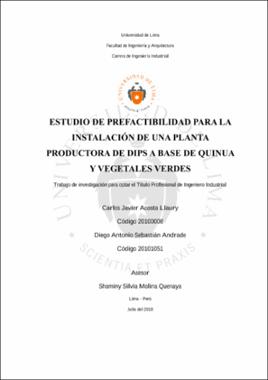Estudio de prefactibilidad para la instalación de una planta productora de dips a base de quinua y vegetales verdes

Ver/
Trabajo de investigación
(application/pdf: 3.519Mb)
(application/pdf: 3.519Mb)
Fecha
2018Asesor(es)
Metadatos
Mostrar el registro completo del ítemResumen
The present study seeks to determine the prefeasibility for the installation of a quinoa and
green vegetables dips manufacturing plant. This product plans to develop an unattended
market and take advantage of one of the main trends: healthy consumption.
In the first three chapters, the general aspects are mainly fixed as: the objectives,
scope, limitations and hypothesis of the investigation; In addition, a market study was
carried out with which 807 274 units of 180 gr were determined as objective demand for
the first year in SES (Socioeconomic Status) A and B of sixth and seventh Lima zones.
Also, after the analysis of pair-wise ranking, Trujillo was chosen as the optimal location
for operations.
During chapter IV, it can be verified that there are no limitations for the project
about technology and resources. However, critical market variables lead to the conclusion
that the optimum plant size for 2022 is 1 014 406 units.
Chapter V, key in the development of the investigation, shows in detail the
engineering of the project. Through DOP, Relational Diagram and Guerchet method, the
minimum required area was calculated and the plant layout was defined.
Finally, chapters VI, VII and VIII analyze the economic and financial viability of
the Cash Flow, Balance Sheet and Income Statement. Obtaining, from an investment of
S /. 1 819 507, a NPV (Net Present Value) of S /. 918 065, IRR (Internal Rate of Return)
of 80.11% higher than Opportunity cost and a recovery period after 1 year and 10 months.
Finally, in chapter IX, the social impact of the project will be evaluated. El presente trabajo de investigación busca determinar la prefactibilidad para la instalación
de una planta productora de dips a base de quinua y vegetales verdes. Este producto
planea desarrollar un mercado no atendido y aprovechar una de las principales
tendencias: el consumo saludable.
En los primeros tres capítulos se fijan principalmente los aspectos generales
como: los objetivos, alcance, limitaciones e hipótesis de la investigación; además, se
desarrolla el estudio de mercado con el que se determinó como demanda objetiva para el
primer año 807 274 unidades de 180 gr en los NSE A y B de la ciudad de Lima en las
zonas 6 y 7. También, luego del análisis de ranking de factores, se eligió como
localización óptima para las operaciones a Trujillo.
Durante el capítulo IV, se puede comprobar que no existen limitaciones para el
proyecto en cuanto a la tecnología y recursos. Sin embargo, variables críticas del mercado
llevan a concluir que 1 014 406 dips para el 2022 es el tamaño óptimo de planta.
El capítulo V, clave en el desarrollo de la investigación, muestra a detalle la
ingeniería del proyecto. A través del DOP, Diagrama Relacional y método Guerchet, se
calculó el área mínima requerida y se definió la disposición de planta.
Por último, en los capítulos VI, VII y VIII se analiza la viabilidad económica y
financiera a través de los Flujos de Fondos, Balance General y Estado de Resultados. A
partir de una inversión de S/. 1 819 507 se obtiene un VAN de S/. 918 065, TIR de 80.11%
superior al COK y un periodo de recupero al cabo de 1 año y 10 meses. Finalmente, en el capítulo IX se evaluará el impacto social del proyecto.
Cómo citar
Acosta Llaury, C. J. y Sebastián Andrade, D. A. (2018). Estudio de prefactibilidad para la instalación de una planta productora de dips a base de quinua y vegetales verdes (trabajo de investigación para optar el título profesional de Ingeniero Industrial). Universidad de Lima.Editor
Universidad de LimaTipo de obra
Trabajo de investigaciónColeccion(es)

